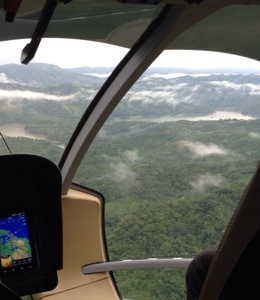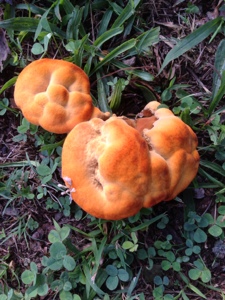
by Loti | May 26, 2014 | Conquering Fear, Insects, Landscapes, Uncategorized, United States
North Carolina. My first hike in years. About 3 miles, considered easy to moderate. I was warned about poison ivy, getting dehydrated and even to be careful of my hiking partner since I had recently met him. Not to mention bears, muggers, mountain lions, snakes and whatever else my catastrophic mind could conjure up. Yikes, should I even go? It is amazing what fear can prevent me from doing (I tend to become immobilized). But it is even more amazing what occurs when I conquer my fears. I had an absolute blast hiking. I felt like I was 8 years and on top of the world. And what a magical world. I half expected a forest fairy to run out and dance around us. We found a huge green lunar moth, tiny wildflowers, moss covered tree trunks, cardinals, streams flowing under old wooden bridges, mushrooms, and millions of plants including jack in the pulpits which I haven’t seen since childhood. And we found this beautiful (remember beauty is in the eye of the beholder)centipede tucked into a rotting log. How very cool. It was so much fun discovering new things around every bend. It just reinforces that life is to be lived, every day. There is magic every where you look. And if I hadn’t faced my fears about the hike? I would have missed one of the best experiences in recent...

by Loti | Oct 12, 2013 | Conquering Fear, Environment, Panama, Plants, Uncategorized
Panama. It is hard for me to comprehend 52 million gallons of water. But it is the amount of water required to move one ship (just one) through the lock system of the Panama Canal. With approximately 40 ships going thru each day, 365 days a year, just do the math. A staggering quantity considering the water is not recycled and ends up in the ocean. So where does it all come from? Is it fresh water or salt? How is it replenished? A lot of questions tumbling thru my brain as we pull into the lock behind a large container ship and the water starts pouring in behind massive gates. And a little unnerving. The water, it turns out, comes from 1.5 million hectares of protected rainforest which surrounds the canal. The day after our partial canal transit by boat, I find myself in one of four cool helicopters (reminding me of the TV show MASH) flying over the rainforest in formation. The water collects in the Gaton Lake (partially seen in the photo) and is released into the ocean (all 52 million gallons) each time a transit is made. Without the forest, there would be no canal. Without the canal, there might be no rainforest since deforestation is occurring at a rapid pace. For me, it is an amazing feat of nature and man working together to provide an efficient trade route between the Caribbean/Atlantic and the Pacific...

by Loti | Sep 16, 2013 | Uncategorized
Florida. So what in the world is my dog thinking as I take this picture? Gibbs, my 15 month old Havanese, has a mind of his own, often not agreeing with me. In fact I keep reminding him, he is the dog and I am the person. It doesn’t always work. But what do we know about how dogs think? It turns out a lot more than we used to know. Research into dog cognition is relatively new, but great strides have been made in the last 10 years. And some of the research is being done by you and me. Emory University is using MRI’s to scan dog’s brains (sounds scary for the dogs, but they are awake and trained to go into the machine) and Duke has a Canine Cognitive Center studying our relationships to our dog friends. So we now know dogs yawn more in response to their owners than to strangers, steal food more often when they think you aren’t looking (what a brilliant strategy!) and interact with friendly robots as opposed to unfriendly robots.Interesting. A new venture called dognition (with some very high powered backers from Duke, Harvard, and others) allows you to complete a questionnaire, play some games and get a profile of your dog. (Could your dog be a Renaissance dog, a Socialite or maybe a Stargazer?). The games are designed to learn more about how your dog thinks. At the same time, dognition is collecting research data from you and your dog for a small annual fee. Brilliant concept and apparently they have plenty of folks signing up. As a proud...

by Loti | Aug 31, 2013 | Food, Health, Plants, Uncategorized, United States
North Carolina. Spotting these cool orange mushrooms on a recent walk in Tryon, NC, I wonder are they are edible? What is their name and do people actually eat mushrooms they find in the wild? With over 14,000 species of mushroom, I may never figure out what these mushrooms are called (an hour searching on the Internet produced no similar pictures). But I do learn over 3,000 species can be eaten with some being very nutritious. However, if you plan on foraging (hunting) mushrooms, you better know what you are doing as over 1,400 mushroom varieties are poisonous. Some deadly. Wow. I had no idea there were that many kinds. And apparently there are numerous mushroom clubs throughout the world and US where people learn about mushrooms, go foraging to collect mushrooms and then gather to cook meals from their forays. A mushroom club? How interesting. So next time you go for a walk, pay attention to the ground. Just since I spotted these mushrooms, I have seen 3 different species. A fascinating wild plant found in urban and rural settings, I look forward to learning more about them. And who knows, I just might send off for a kit to grow some at home and join a local club. Now that is...
by Loti | Mar 11, 2013 | Uncategorized
Thailand. Traveling to the southwest corner of Thailand, we flew into Krabi. The waters around Krabi and Phuket, about a 2 hour drive between the 2 cities, is known as the best all season sailing waters in the world. On a private longboat ride we were able to visit some of the numerous limestone karsts (a great scrabble word) in the Andaman Sea, located off the southwest coast of Thailand. A karst is a unique landscape found all over the world, including in Indiana (go figure), formed by the underground erosion of rocks such as limestone. And these are indeed limestone karsts. This area of the world has no winter and an average temperature of 82 degrees for both the water and air temperature. There are no hurricanes or typhoons (this place is looking better and better), however….. Isn’t there always a but? The 2004 tsunami devastated the entire region which lies on the ring of fire where 90% of the world’s earthquakes occur. Oh my. We didn’t see signs of the devastation and I am very glad I didn’t read about it in detail until we got home, but it is a real threat. Funny, no one mentioned it at the resort we stayed....
by Loti | Feb 27, 2013 | Thailand, Uncategorized
Having never heard of Jim Thompson until researching our trip to Thailand, he is now one of those people I would have loved to meet. He was an American, who single handedly, revitalized the Thai silk industry after World War II. He was also was an architect, retired army officer, a spy (that is the one I am really intrigued by), an antique collector and a silk merchant. In the picture, we are at The Jim Thompson house, run by the Foundation established in his name, watching silk being spun from cocoons. The cocoons are boiled and a single thread at a time is pulled and put on a spool. It is then used to make beautiful silk cloth. More on silk later, but the story of Jim is fascinating. After retiring from what is now known as the CIA, he moved to Thailand and started the Thai Silk company. He convinced Vogue magazine to do an article on his silks and then achieved a great coup when his Thai silks were used in the movie production of The King and I in 1951. He helped raise thousands of Thai’s out of poverty by providing them with a living making silk. He built a beautiful house in Bangkok, filled with antiques he collected and entertained royalty. Then on Easter Day in 1967, he went for a walk in Malaysia while on holiday and was never seen again. Much speculation exists about a possible kidnapping by all sorts by shady characters or maybe even a tiger ate him. Oh my. But the mystery remains to this day. And the silks...





